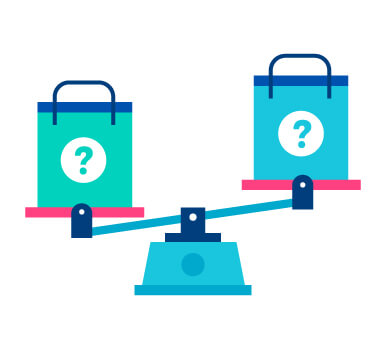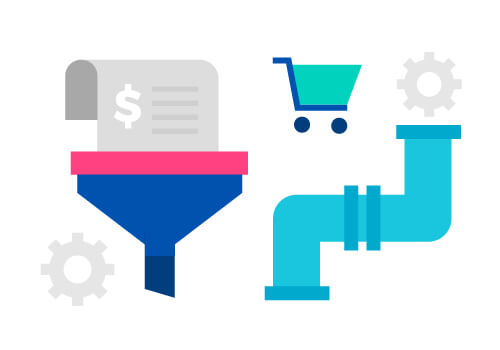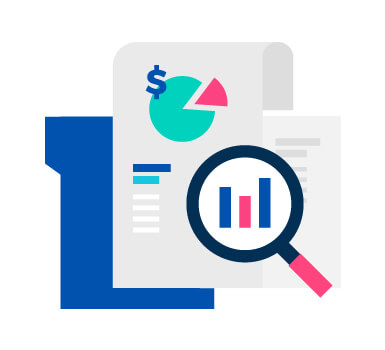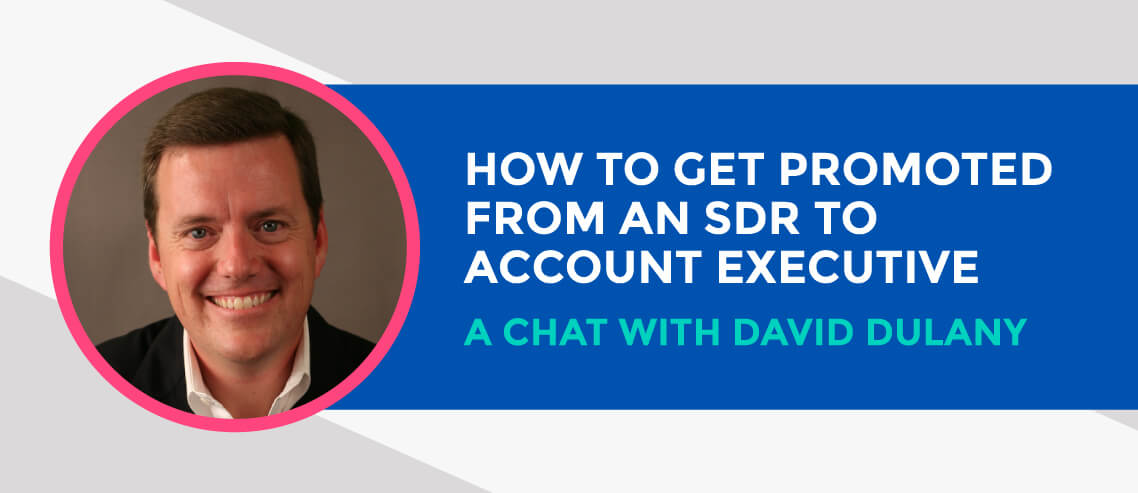What Is a Sales Pipeline? Everything You Need To Know

Contents
A picture is worth a thousand words.
Your sales pipeline is, in essence, a picture – a visualization of the sales process.
But just because you’ve put together a visual representation of your deals in progress doesn’t necessarily mean you’ve got the secret recipe down pat. In fact, 63% of executives believe their teams could improve their sales pipelines efforts and use the information more efficiently.
However, if you work to analyze and perfect your sales pipeline stages and efforts, it really could be worth thousands (in dollars, not words) because of the increased efficiency and success you’ll generate.
What is a sales pipeline?
The sales pipeline is a step-by-step representation of the path your customers take to close a deal with you. Each organization’s pipeline may be a little different, but generally, they’ll contain these stages or other very similar options.

Sales Pipeline Stages
Stage 1: Prospecting
Prospecting is the first step in the sales pipeline.
When you are prospecting, you’re identifying the people who may have an interest in your product, then working to make sure your offerings are visible to them.
There are multiple different approaches to prospecting. Because not every sales prospect turns out to be a good fit (less than half of initial prospects do), good sales teams will use more than one way to generate interest from prospects.
- Cold prospecting: In this approach, your team reaches out to potential clients through a variety of avenues. Some of the more popular methods of prospecting include cold calling and social selling.
In both of these approaches, your goal is to reach out to someone who hasn’t yet engaged with your company, and to move them into your sales pipeline.
- Warm prospecting: This method of prospecting is focused on making a connection with potential clients who’ve shown interest in your product or service. For example, if you have a free case study available on your website and ask site visitors to submit their email address or complete a form, they become warm prospects.
They’ve signaled that they have enough interest in your product to share personal information and to agree to receive information from you in their mailbox on occasion.
Some companies may use options like chatbots on their websites to start AI-driven conversations and scope out a prospect’s level of interest. Other ways to find warm prospects include social media connections/page likes, referrals from friends or colleagues, and event-based marketing.
Stage 2: Qualifying
After a prospect has been identified, the next goal in the process is to determine the prospect’s actual level of interest and continue to move them forward through the pipeline. At this point, if they’re serious, a prospect is upgraded to a lead.
Some companies’ pipelines may include multiple versions of qualification; for example, they may determine whether leads are both marketing qualified (MQL) and sales qualified/sales accepted.
Marketing qualified leads are prospects who are judged/scored based on their propensity to move forward in the process. This judgement, called lead scoring, is made based on data and can be tabulated based on an algorithm or on your own manual scoring processes.
Sales qualification or sales acceptance is the next step in vetting an MQL and moving it along the process.
To qualify a sales lead, a bonafide conversation typically needs to take place to determine whether the prospect is truly interested, currently in the buying process, and responsible for making the purchasing decision on behalf of their company.
Stage 3: Consideration
When you have determined that a lead fits your criteria, you can continue targeted and personalized outreach to them through content distribution, marketing automation, and other similar channels.
During the consideration phase, your leads will review your offerings to make sure they fit their business needs and budget. At the same time, they’re also probably reviewing similar products from your competitors, either to see how they stack up or to get the requisite number of bids required by their corporate policy.
While your leads are in the consideration stage, it’s in your best interest to provide targeted information that helps them make a decision.
For example, if you paid attention during earlier conversations with your prospects/leads, you might have picked up on some of the pain points they experience with their current processes. A smart salesperson knows the best way to keep them moving in the pipeline is to make your product personal.
You can do this by giving them information on how you’ve solved specific problems that are similar to theirs, or how you’ve improved processes and efficiency for companies struggling with the same problems.
And, making the choice to follow up with specifics (rather than with generic messages) can pay off. A study of marketers using email personalization saw much higher-than-average engagement with their messages; for example, 75% earned higher click-through rates, and 56% generated increased revenue.
Stage 4: Purchase/Decision
The purchase step seems like it could be an easy one to negotiate. After all, if you’ve kept your prospect loyal through all the preceding steps, it should be a piece of cake to get the documents signed and make it official, right?
Not quite. According to LinkedIn, 24% of forecasted deals go dark. To avoid this frustration, it’s important to remain in close contact with your lead, anticipating their objections and handling their concerns to make the sale.
Whatever you do, don’t let a deal get caught in limbo at this stage. Either your buyer is ready or they’re not.
It’s important to get a decision from them one way or another, rather than letting their interest go lukewarm and losing the connection altogether, or dragging out the process and wasting everyone’s time and money.
Stage 5: Delivery
With any luck (and all the hard work you’ve put in), you’ll get an approved deal and will be able to deliver your product or service to your new client.
At this point, are you finished? Not quite.
In the delivery stage, it’s important to make good on any promises you’ve made. You can create a smooth transition for the client, moving them from working directly with sales to partnering with your customer success professionals. From there, customer success can work with them on integrating the product, maximizing its effectiveness, and ensuring both renewals and upsells.
What’s the Difference Between a Sales Pipeline and a Sales Funnel?
The words sales pipeline and sales funnel are often used almost interchangeably. However, they each play a distinct role in the sales process.
The purpose of the sales pipeline is to know where your prospects are, how they’ve progressed each step of the way, and what your team’s next steps should be to win them over.
In a sales/marketing funnel, you’re working with numbers and playing the odds. For example, if you’re focusing on making cold calls to create awareness of your product, you expect that if you make X number of calls, you’ll have X number of clients proceed to the next step.
Your marketing funnel may include steps like awareness, interest, evaluation, and engagement. As your prospects are making their way through those steps, you can’t necessarily control their movement through the process.
Prospects in your sales funnel may not always cooperate with your prescribed plan of action. Instead, they may choose to hop back and forth, engage with another company’s content, or go completely silent.
If you haven’t yet created a relationship with them and qualified their interest, you may not have any idea why they’re not progressing to making a decision.
Your goal should be to urge them (gently) to increase their awareness and interest in your product. Once you have their attention, you can include them in your more controlled sales pipeline process.
The funnel can tell you what your browsers and suspected prospects are doing; for example, it can show that you added 200 new prospects and that 50 of them moved through the funnel. It doesn’t tell you what else they’re doing as they go through their initial and mid-stage processes, or how truly interested and engaged they are.
However, the interested parties exploring your product will then be funneled into the sales pipeline. At this point, with your touchpoints and guidance, they’ll be able to formally evaluate what you can offer.
With a pipeline, you can determine precisely where a prospect is in the process, report on it, and ensure you keep them moving forward. You can also know how many deals are in the works, their current stage, and whether you’re likely to hit your sales goals based on what you have going now.
The funnel’s steps are used to attract prospects and engage their attention. The pipeline takes prospects that have indicated their interest, then continues to move them toward ultimately choosing your product.
One of the most important distinctions between a funnel and a pipeline is the action required by your team.
In the sales pipeline, a specific sequence of actions by your team members is required to make connections and sell your products. For example, you may set up automated systems, then supplement them with options like Lead Catcher to manage multiple leads and conversations, ensuring nothing slips through the cracks.
Tips for Building and Managing Your Sales Pipeline
The steps listed above give you an idea of how to get started with building your own sales pipeline. However, you should also look for additional opportunities specifically suited to your industry, and find ways to set yourself apart from the competition.
Find Options to Differentiate
For example, mortgage lenders typically have a long turnaround on personal loans, which coincides with periods of high stress for the prospective buyer. In a mortgage sales pipeline, it could make sense to contact the loan recipient during the process when there’s a certain amount of lag time.
By scheduling that unusual connection into your pipeline, you can touch base, educate them on the delays, and make them feel comfortable with the situation. You’re keeping them engaged with your product, potentially introducing the opportunity to upsell loan-adjacent products like home insurance, and most importantly, making them feel supported so they don’t start shopping around with other flashy lending firms.
Use Automation to Move Things Forward Where Possible
Incorporating automation into your marketing strategy can greatly increase your number of qualified leads.
Research shows that businesses that used automation to nurture prospects saw a 451% increase in qualified leads. Using automated omnichannel prospecting outreach tools can guide you as you build campaigns to support your pipeline goals.
And, on the practical side, it can take 6 to 8 touches to create a viable lead; setting up automated systems to manage those ongoing follow-ups can reduce the labor burden on your team, while at the same time making sure the prospect feels noticed and appreciated.
Make Data Analysis a Valuable Part of Refining Your Sales Pipeline
Take advantage of reporting data, and look for opportunities you can create from it. For example, if you see a lot of leads falling out or going dark at a certain step within your pipeline, that likely indicates a problem.
Once you have the numbers showing you where prospects are getting hung up, you can determine a proper solution to shore up sagging sales.
For example, if a lot of leads are dropping out at the consideration level, you might be lagging behind others in the field as far as innovation goes, and might be dropping out of their contender list for that reason. If you’re seeing candidates disappear at the negotiation or purchase/decision stages, you may want to take a closer look at your pricing, or see whether you need to tweak your ideal buyer persona to more accurately reflect the scale and budget of your desired prospects.
The sales pipeline is at the core of your sales success. By refining it and creating a process that fits your business, you’ll continue to improve your efforts and make your sales team better.





